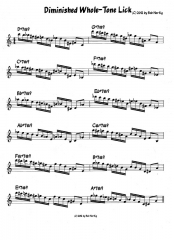Tonight’s post is low on text but high in content. Click on the image to enlarge it, then print it out and take it with you to your next practice session and start adding a nice new lick to your diminished whole-tone collection.
Not much to say about this little gem that you can’t figure out for yourself, but here are a few points of interest:
- ♦ The lick begins and ends on the flat seventh of the V+7(#9) chord.
- ♦ Beats two and three highlight the major triad that’s formed off of the raised fifth of the parent chord. For example, if you’re playing a D+7(#9), the raised fifth is A#–or Bb, enharmonically–and beats two and three will accentuate an A# (Bb) major triad. You can look at it as chord superimposition.
♦ The last beat emphasizes the two “identity tones” of the dominant chord, leaping a tritone from its third to its lowered seventh.
That’s all. Have fun with it! And if you enjoyed this post, check out my large and ever-growing library of jazz theory, technique, and solo transcriptions.


